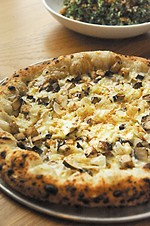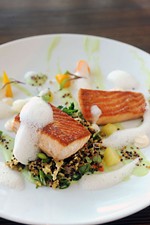Candy Hell
Or, it takes a lot of patience to play Mrs. Santa Claus
By Virginia B. Wood, Fri., Dec. 19, 2003
Candy making has been part of my holiday ritual my entire adult life. Once I began cooking and making desserts, an unquenchable sweet tooth determined that I would indeed make candy. Sugary pecan pralines like the ones I remembered from childhood trips to Manuel's in Odessa, crunchy English butter toffee topped with a little semisweet chocolate, a rich creamy fudge, billowy clouds of nutty divinity, and peanut brittle with the perfect sweet-salty crackle: Those were my goals. Pralines came first, of course, and they turned out to be a snap. I found the most forgiving candy recipe in the world in the original Old Bakery Bake Book (now long out of print), substituted buttermilk for heavy cream, and have been making sugary (my preference) rather than chewy pralines (ô la Lammes -- good, but just not my thing) ever since. A very simple, basic toffee came next, discovered in a New York Times collection of American regional recipes. It's just butter, sugar, salt, vanilla, and water with a little semisweet chocolate on top, but it's amazing what magic can be made when butter and sugar are cooked to just the right temperature. I eventually developed a pretty unique chipotle chile fudge that I'm proud of, and those three candies have become my holiday standards. Over the years, I burned up several mixer motors trying to make divinity in Austin's humidity, but the soft, billowy clouds of my imagination continue to elude me. I'm still determined there's a signature peanut brittle out there in my future, but I haven't mastered it as yet. I do what I do fairly well and my friends and family seem to like it.
Until this year. This year, I got a wild hair and decided it was time to invest large sums of money in Mauviel French copper candy pots. It was really a good idea, considering that copper is the best conductor of heat, and the Mauviel pots are world famous for cooking fruit preserves and sugar. As the popularity of my holiday toffee grew, it had become necessary to find bigger and bigger pots in which to cook it. The expanded toffee recipe had long outgrown my original candy pan, the trusty 3-quart Magnalite pot that still turns out perfect pralines. In my search for new cooking vessels, I've managed to ruin two beautiful Le Creuset enamel Dutch ovens (very expensive mistakes) and put a permanent burn in the bottom of my heavy-duty Magnalite (now irreplaceable) soup pot. Two years ago, I switched to a Calphalon no-stick deep pot, but then I read news stories about minute particles of nonstick coating coming off in the food, and that worried me. The Mauviel pots were a good idea, environmentally safe, unlikely to burn, and a good lifelong investment. So there.
The truth is, the pots themselves weren't really the problem, they just slowed me down a bit. I'd never owned copper pots before, so I didn't realize they come with a protective coating that has to be removed before it's safe to cook in them. According to the hilariously translated instructions in the pots, this was to be accomplished by bathing the pots in boiling water to which a fair amount of baking soda has been added. After hours of pouring boiling water in the too-shallow sinks, I was soaked with bicarbonate of soda water, and the pots retained their protective coating. On to plan B. A friend spent hours with acetone (fingernail polish remover) and big cotton pads, removing the covering one little section at a time. Now we're two days behind schedule, candy deadlines are fast approaching, and we still haven't tried out the new pots.
Once I ordered the new pots, it occurred to me that it might be a good idea to try a new butter this year, one with a higher butterfat content than what I'd always used. I'd found over the years that it was necessary to use Land O Lakes or a similar quality butter to make the toffee. Butter with too much water and a butterfat content lower than 36% is likely to burn at the high (305 degrees) temperature necessary for successful toffee. A few degrees off in either direction, and you get an all-day sucker that will pull the teeth right out of your head or a sheet of very crunchy candy with a distinctive burned flavor. Even better butter meant even better toffee: That was my thinking. I spoke with an area sales rep for a baking supply outfit, and he told me where I could get a sample of an imported butter from New Zealand -- bright yellow, creamy sweet, and ultra-rich. In my fantasy, I was whipping up toffee in my new French copper pots, using the voluptuous New Zealand butter and Isle de Rey salt from the coast of Brittany. A new taste sensation! What a fool.
The third key component to this fiasco is the candy thermometers. With the advent of digitalization, candy-thermometer technology has improved greatly in the past few years. I'd finally given up my old Taylor clip-on mercury thermometer in favor of a snazzy little Williams-Sonoma model that has a plastic body with a digital screen and a temperature probe attached with metal wire. It was perfect for candy making and tempering the chocolate that goes on top of the cooled toffee. My backup is a candy/oil thermometer, a long probe that clips on the side of the pan with a digital readout on top. I put new batteries in both models, just to be safe, and the cooking began.
Bright yellow butter, sugar, salt, water, medium heat, thermometer in place: All that was left to do was to stir for an hour or so, and we'd see how things worked out. Time after time, disaster struck. As the candy mixture would reach the hard-ball stage, it would begin to break down, and by the time the temperature read more than 270, the mixture would separate. The one time I was able to cook the candy to the desired temperature and remove it from the heat to add the vanilla, the entire mixture completely broke down once the vanilla burned off, leaving a layer of thick, caramelized sludge on the bottom of the gleaming new pot with rendered fat above it. I backed up and tried a small batch. Nothing doing. I did, however, begin to notice alarming discrepancies on the thermometer read-outs and finally had to face the fact that neither one was working properly. Someone was dispatched to Williams-Sonoma, only to find out they no longer make my favorite model, but did indeed have my second choice, the long probe with the digital readout screen on top. Then, at Chef's Toolbox, we found a new Taylor digital model almost exactly like the W-S one I'd come to love. More than $100 worth of thermometers later, we were trying again. Over the course of two days, we ceremoniously dumped several disastrous batches in a secret spot outdoors. It was one of those situations where if I still drank, I'd have been drinking. In all probability, the higher quality of the über-butter had thrown off the fat/water/sugar ratios of my old reliable recipe, and I finally had to admit I'm not a good enough candy chemist to figure out how to make it work. I wanted to run screaming down the road, getting as far away from candy making as I possibly could, but instead I sent someone to the store for Land O Lakes butter and got back to work. It takes a lot of patience to be Mrs. Santa Claus. ![]()








